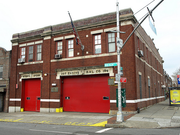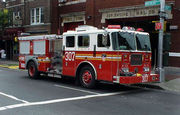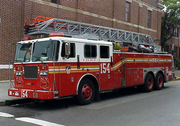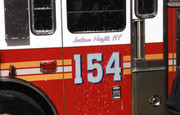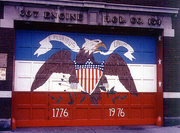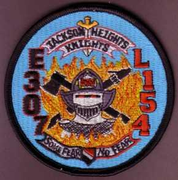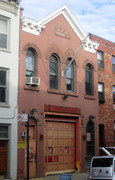REOPENING OF ENGINE 232 FORMER FIREHOUSE AS EMS STATION 44 - NEW YORK DAILY NEWS - Monday, December 7, 1998, 12:00 AM
"EMS HAS HOME WHERE FIREHOUSE VANISHED" by Bob Liff
IT SEEMS SOMEHOW appropriate that the Fire Department chose today the anniversary of the Japanese Navy's 1941 sneak attack on Pearl Harbor to officially reopen the Tin House in Ocean Hill-Brownsville. This time around, it will serve as a base station for the city's Emergency Medical Service, now a part of the FDNY. It was during the 1988 Super Bowl just as the Redskins' Doug Williams was throwing a record five second-quarter touchdowns that firefighters from Engine Co. 232 at the Rockaway Ave. house were lured out on a phony lights-and-sirens run halfway across Brooklyn. The shrimp and mushrooms left behind on the stove were not even cold when they arrived at their Tillary St. destination only to be told they were being put permanently out of service. Even in a city where municipal assaults on dignity are all too common, what became known as the "Super Bowl sneak attack" displayed unparalleled contempt for the firefighters and the struggling community they protected. Mayor Ed Koch compounded the insult by congratulating himself for a "brilliant" maneuver. He crowed that the secrecy blocked the kind of protests that culminated in Bronx activists chaining themselves to Engine Co. 41 to keep that house open.
"In order to avoid the fire engines being taken hostage, the subterfuge was used," Koch said last week. "I don't have any regrets."
He should. Current Fire Commissioner Tom Von Essen, then a Uniformed Firefighters Association official, called the actions "despicable."
"What would have happened if the truck hit a kid on a bicycle as it raced across town," Von Essen said last week. "I'm proud that Mayor Giuliani is bringing back some dignity to that building."
It was the way the firehouse was closed even more than the closure itself that set off torrents of outrage. Union officials tried without success to file criminal false-alarm charges against top departmental officials. Five thousand firefighters marched over the Brooklyn Bridge and ringed City Hall to denounce the closure. Bergen St. resident Gwen Jacobs, whose family had been saved from a burning building months earlier by members of Engine 232, was transformed into a political activist. Jacobs, who now heads the New York chapter of ACORN, joined with Borough President Howard Golden to push quick City Council approval of a law requiring 30 days' notice before closing firehouses. And mayoral candidate Rudolph Giuliani received the UFA endorsement in front of the shuttered Tin House and pledged to reopen it. Giuliani lost that 1989 election, but won four years later. Maybe it did take him five years to reopen the building, a lot longer than his quick reopening of Engine 294 in Richmond Hill, Queens. And maybe an EMS station is not the same as a firehouse. But Giuliani deserves credit for seeing that justice, even if delayed, was not denied forever to Ocean Hill-Brownsville. Jacobs applauds the building's reopening, even if she tempers praise for Giuliani.
"He had to find someplace to put the ambulances, and here was a building already in place," she said. "If he had opened it like he opened other firehouses, I would say to give him more credit."
But Von Essen said Giuliani pressed to use the Tin House as part of the city's plan to better deploy EMS units. The building has undergone a gut renovation, its tin walls replaced by a stucco covering. Shifting six units from Pennsylvania Ave. will cut potentially lifesaving minutes from the time that paramedics take to restock and change shifts. AND FOR OCEAN Hill-Brownsville, it restores a round-the-clock presence to an area that continues to rise from the ashes that Engine Co. 232 had worked so hard to prevent.
"EMS HAS HOME WHERE FIREHOUSE VANISHED" by Bob Liff
IT SEEMS SOMEHOW appropriate that the Fire Department chose today the anniversary of the Japanese Navy's 1941 sneak attack on Pearl Harbor to officially reopen the Tin House in Ocean Hill-Brownsville. This time around, it will serve as a base station for the city's Emergency Medical Service, now a part of the FDNY. It was during the 1988 Super Bowl just as the Redskins' Doug Williams was throwing a record five second-quarter touchdowns that firefighters from Engine Co. 232 at the Rockaway Ave. house were lured out on a phony lights-and-sirens run halfway across Brooklyn. The shrimp and mushrooms left behind on the stove were not even cold when they arrived at their Tillary St. destination only to be told they were being put permanently out of service. Even in a city where municipal assaults on dignity are all too common, what became known as the "Super Bowl sneak attack" displayed unparalleled contempt for the firefighters and the struggling community they protected. Mayor Ed Koch compounded the insult by congratulating himself for a "brilliant" maneuver. He crowed that the secrecy blocked the kind of protests that culminated in Bronx activists chaining themselves to Engine Co. 41 to keep that house open.
"In order to avoid the fire engines being taken hostage, the subterfuge was used," Koch said last week. "I don't have any regrets."
He should. Current Fire Commissioner Tom Von Essen, then a Uniformed Firefighters Association official, called the actions "despicable."
"What would have happened if the truck hit a kid on a bicycle as it raced across town," Von Essen said last week. "I'm proud that Mayor Giuliani is bringing back some dignity to that building."
It was the way the firehouse was closed even more than the closure itself that set off torrents of outrage. Union officials tried without success to file criminal false-alarm charges against top departmental officials. Five thousand firefighters marched over the Brooklyn Bridge and ringed City Hall to denounce the closure. Bergen St. resident Gwen Jacobs, whose family had been saved from a burning building months earlier by members of Engine 232, was transformed into a political activist. Jacobs, who now heads the New York chapter of ACORN, joined with Borough President Howard Golden to push quick City Council approval of a law requiring 30 days' notice before closing firehouses. And mayoral candidate Rudolph Giuliani received the UFA endorsement in front of the shuttered Tin House and pledged to reopen it. Giuliani lost that 1989 election, but won four years later. Maybe it did take him five years to reopen the building, a lot longer than his quick reopening of Engine 294 in Richmond Hill, Queens. And maybe an EMS station is not the same as a firehouse. But Giuliani deserves credit for seeing that justice, even if delayed, was not denied forever to Ocean Hill-Brownsville. Jacobs applauds the building's reopening, even if she tempers praise for Giuliani.
"He had to find someplace to put the ambulances, and here was a building already in place," she said. "If he had opened it like he opened other firehouses, I would say to give him more credit."
But Von Essen said Giuliani pressed to use the Tin House as part of the city's plan to better deploy EMS units. The building has undergone a gut renovation, its tin walls replaced by a stucco covering. Shifting six units from Pennsylvania Ave. will cut potentially lifesaving minutes from the time that paramedics take to restock and change shifts. AND FOR OCEAN Hill-Brownsville, it restores a round-the-clock presence to an area that continues to rise from the ashes that Engine Co. 232 had worked so hard to prevent.













































